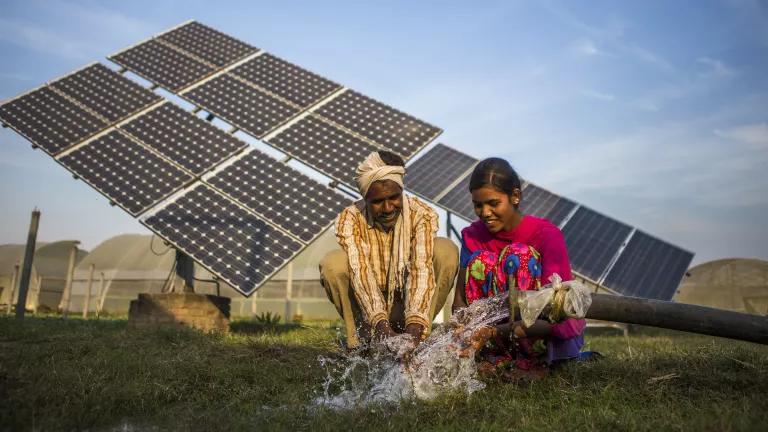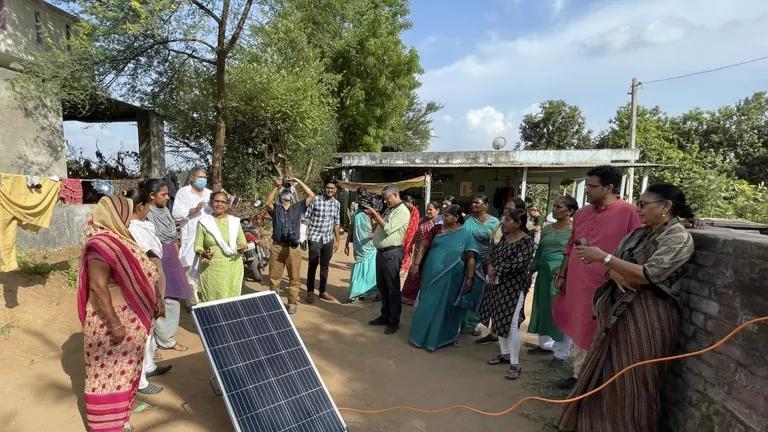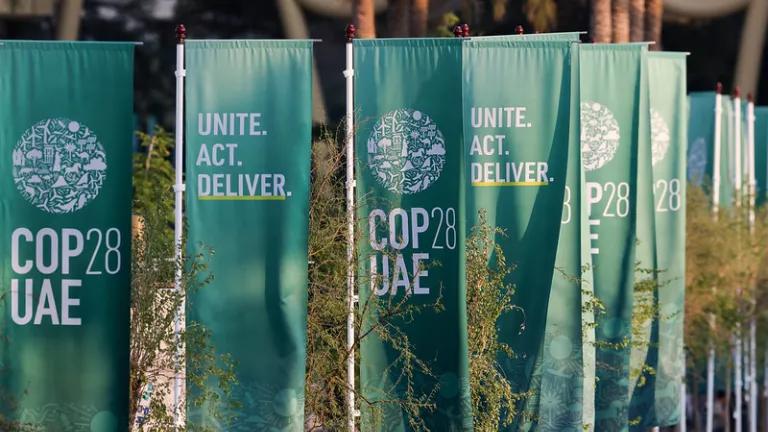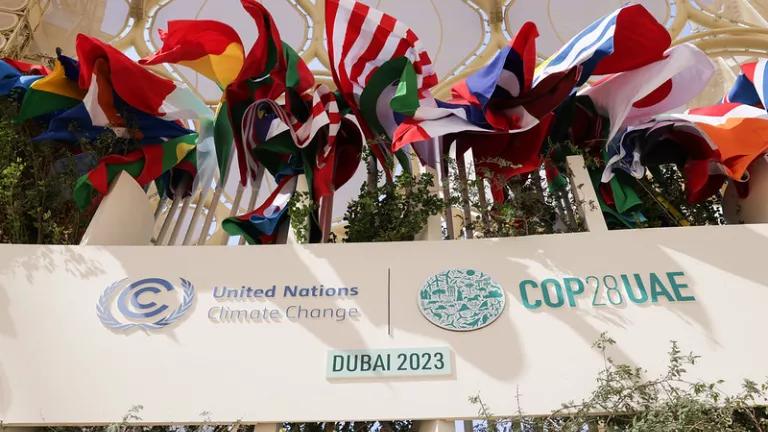
Farm workers rinsing their hands with water from a solar-powered pump at a farm in Jagadhri
India Green News is a selection of news highlights about environmental and energy issues in India.
July 13 – July 20, 2017
CLIMATE CHANGE
Indian Builders Pledge "Green" Homes in Race to Meet Climate Goals
India's top builders have pledged to make at least a fifth of their new housing developments sustainable by 2022, as the country looks to tap sectors other than renewable energy to meet its ambitious climate goals.
The campaign is led by the Sustainable Housing Leadership Consortium (SHLC) comprising builders Godrej Properties, Mahindra Lifespaces, Shapoorji Pallonji, Tata Housing and VBHC Value Homes. It is backed by the Ministry of Housing.
Builders will use mainly local and recycled material, and design homes that conserve water and electricity and make best use of natural light and wind patterns, while also pursuing more energy-efficient methods of construction….
(Reuters – July 19, 2017)
Climate Change to Put India at High Risk of Flooding, Decrease Crop Production by 8%: Study
Climate change would bring devastating consequences to countries in the Pacific and Asia, a new report has warned and said Southern India may witness a decline in rice yields by five per cent in 2030s.
Unabated climate change could severely affect the future growth of these countries, reverse current development gains, and degrade quality of life, the report by the Asian Development Bank (ADB) and the Potsdam Institute for Climate Impact Research (PIK) claimed.
According to the report, Asia has the highest number of people exposed to flooding from possible storm surge events, particularly in the People's Republic of China (PRC), India, Bangladesh, and Indonesia….
(First Post – July 15, 2017)
Climate Change: India Begins Work on Meeting Its Obligations Under the Paris Agreement
The central government has commissioned three research institutions to project a long-term low carbon growth trajectory for India. This is the first step India has taken domestically to achieve its commitments under the Paris Climate Change Agreement.
The Energy Research Institute, Observer Research Foundation and Center for Study of Science, Technology and Policy are tasked with recommending three different future low carbon growth scenarios for the country. The three institutions are expected to come up with their findings in about a year, well before the implementation of the Paris Agreement begins in 2020. Their studies will project economic growth and concomitant greenhouse gas emissions for the period 2030-45.
A long-term low carbon growth strategy essentially requires a developing country to plan the set of actions that ensure future economic growth lowers the rate of growth in greenhouse gas emissions than achieved in the past. In the climate jargon, this is described as “decoupling growth from emissions”….
(Scroll.in – July 13, 2017)
ENERGY
India's First Solar-Powered DEMU Train Launched
The Railways on Friday launched the country’s first solar-powered local train here with a battery bank facility that ensures sufficient power even in the absence of sunlight.
The entire electrical need of the coaches, which includes lights, fans and information display system, will be met by the energy produced by solar panels fitted atop the coaches of the DEMU (diesel electric multiple unit) train.
Speaking at the launch at the Safdarjung railway station, Union Railway Minister Suresh Prabhu said it was a “path-breaking leap” towards making trains more environment-friendly.
Referring to the Railways commitment to using cleaner fuels, Mr. Prabhu said it was trying to increase the use of non-conventional sources of energy.
Also, the carrier is taking on several other environment-friendly measures like using bio-toilets, water-recycling, waste disposal, CNG and LNG, and harnessing wind energy…
(The Hindu – July 15, 2017)
Indian Rooftop Solar Nearly Doubles in a Year
India reached 1,396MW of rooftop solar deployment at the end of March, with nearly half (678MW) of this installed just in the fiscal year 2016-17, according to the latest ‘India Solar Rooftop Map’ from Bridge to India.
The success of the last 12 months marked year-on-year growth of 81%, with an expected y-o-y growth of 76% in the current financial year and the surpassing of 2GW total deployment. The current year’s growth will be driven by ongoing and recently completed rooftop solar tenders. The public sector will also see an impressive 205% growth during this period.
In terms of states in 2016-17, Tamil Nadu, Maharashtra, Rajasthan, Gujarat and Karnataka accounted for 40% of total rooftop solar capacity addition in the country…
(PV Tech – July 14, 2017)
IFC Plans up to $6 Billion India Investment Over 5 Years on Renewable Energy, Green Buildings
International Finance Corporation (IFC), a World Bank Group member, is planning to invest up to $6 billion in India over the next five years to support initiatives in renewable energy and green buildings, said a top official of the institution.
“We have already invested over $2 billion in green buildings initiatives in India since 2005. Over the next five years until 2022, we will be investing $5 billion to $6 billion on climate-change led initiatives,” said Jun Zhang, India Country Head, International Finance Corporation.
Out of this proposed investment, around 20% will be invested in efforts towards green buildings initiatives, while rest will be in climate change led and sustainable development projects…
Currently, India accounts for around 2% of world’s existing green buildings and with the proposed investment, IFC is looking to increase the number to 20% over the next five years. The investment will be in the form of loans that will be extended to developers of green buildings…
(Economic Times – July 18, 2017)
India's Blue Sky Pledge Gives Power to Country's Green Bonds
Green bonds issued by Indian companies are gathering pace as the country’s ambitious target for renewable energy fuels interest from investors.
Renewable energy developer Greenko Energy Holdings raised $1 billion earlier this week, making it the largest corporate green bond issuer in Asia, Bloomberg data shows. It beat MTR Corp.’s $600 million issue in November. Green bonds from India are likely to increase as renewable capacity expands and the market gets bigger, according to Ashish Sethia, head of research and analysis for Asia Pacific at Bloomberg New Energy Finance.
Indian renewable energy developers face the highest nominal cost of debt in local currency across key markets in Asia and the Pacific region, and they will “continue to seek avenues to reduce costs, including in overseas markets where investor interest is rising,” Sethia said…
(Bloomberg – July 18, 2017)
Power Grid Integration to Quicken Renewables Makeover
When the sun shines brightly, it’s manna from heaven for a solar producer. But for the electricity distributor, the surge in the power lines can be a nightmare. This unpredictability of solar and wind energy has long been a technical challenge that requires adroit balancing of the power grid.
India is now on the threshold of attaining this balance. The new Greening the Grid report, prepared by India’s Energy Ministry and the US Agency for International Development (USAID), has confirmed the technical and economic viability of integrating 175 GW of renewable energy into the country’s power grid by 2022, and identifies future course of actions that are favorable for such integration.
The growth in India’s renewable energy (RE) sector accelerated sharply after the government in 2015 announced an ambitious target of adding 100 GW of solar and 60 GW of wind capacity by 2022, with biogas and other clean energy sources adding another 15 GW. As a result, from July 2015 to December 2016, developers in India have snapped up contracts to set up 15.9 GW of solar projects…
(India Climate Dialogue – July 17, 2017)
ENVIRONMENTAL HEALTH AND AIR POLLUTION
The scarcity of water in India makes it difficult for water and energy sector officials to trade-off between power generation and the use of water for drinking, agriculture, and other industries. Some analysts argue that in a water scarcity scenario, power generation will come at the expense of other uses. A new Greenpeace report notes if the Indian government continues to push for the construction of more coal plants, the water crisis will grow significantly worse. The report estimates over 170 GW of coal power plants, representing 40 percent of the proposed Indian coal fleet, are in areas that are facing high or extremely high water stress.
A report issued by the Prayas Energy Group agreed that the construction of ever more water-cooled coal-fired power stations would cause “immense stress” on water resources in the areas close to plants. The authors also cautioned that, due to variations in annual rainfall, there was no guarantee year-round water would be available for power stations….
(The Diplomat – July 13, 2017)
Ozone Pollution Rising in Delhi's Air, Shows Data
Apart from causing pulmonary disorders and respiratory infections, rising levels of Nitrogen Dioxide in Delhi’s air can also worsen ozone pollution.
A recent analysis of real-time air quality data from monitoring locations of Delhi Pollution Control Committee for the summer months of 2016 and 2017 has revealed that ozone pollution has been worsening progressively with the onset of summer. The analysis was done by experts from the Centre for Science and Environment (CSE).
“Ground-level ozone is not directly emitted by any source. This is formed when oxides of nitrogen (NOX) and a range of volatile gases, primarily from vehicles and other sources, are exposed to each other in sunlight,” said Anumita Roychowdhury, executive director (research and advocacy) CSE…
(Hindustan Times – July 18, 2017)
Compiled by Henry Ruehl
Note: The linked articles and excerpts in this post are provided for informational purposes only and do not necessarily reflect the views or positions of the India Initiative or of the Natural Resources Defense Council.



